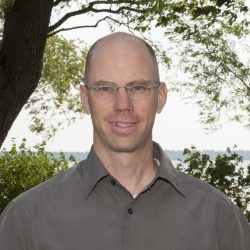Biography
I joined the Center for Sustainability Studies in the fall of 2014 and my teaching and research focus on maintaining and improving water quality. Many of our lakes and rivers in Minnesota are stressed from our unsustainable activities on the land and on the water. We need to empower students at BSU and people across Minnesota to understand the problems we face and make effective change in how we treat our lakes and rivers. To that end, I work with students on a variety of topics including: why there are consumption advisories for fish caught from most lakes in Minnesota, how our lakes are turning from sky blue to pea soup green, why male fish downstream of wastewater treatment plants produce eggs, and how microbes are still breaking down oil spilled 40 years ago.
Degrees
B.S. in Chemistry from Bemidji State University
Ph.D in Chemistry from Oregon State University
Post Doctoral Fellowship- EPA Athens, Ga
Post Doctoral Fellowship- EAWAG- Swiss Federal Institute of Aquatic Science and Technology- Dubendorf, Swistzerland
Visiting Scientist- Research Center for Eco-Environmental Sciences-Chinese Academy of Science, Beijing, China
Teaching
Introduction to Environmental Science
People of the Environment
Sampling and Analysis
Wastewater Treatment
Environmental Toxicology
Environmental Chemistry
Research Interests
Endocrine disruption in aquatic species in Northern Minnesota. When male perch are exposed to endocrine active substances they can start to develop female attributes, such as increased egg your protein concentrations and some even produce eggs in their testes. Every spring during my Environmental Toxicology class my students collect perch from across Minnesota and we measure the concentration of the egg yolk protein, vitellogenin in the livers of these fish. Students compare male and female vitellogenin concentrations to determine how it varies with gender and if it increases downstream of human wastewater inputs. This work was highlighted in the Bemidji Pioneer during the summer of 2020.
Hyperspectral Imaging
I am working with CSS graduate students to develop Hyperspectral Imaging capabilities to identify algae blooms in our impaired lakes. Each surface has a unique reflectance spectra and we are working to develop methods to identify the chlorophyll reflectance spectra from impaired surface waters. To this end we are working to interface our hyperspectral camera and our hexacopter drone to permit us to fly our hyperspectral camera over lakes to identify areas with impaired surface water.
Transient Electrical and Magnetic Signals: Miriam Rios-Sanchez and I have been working with Lee Slater and Dimitrios Ntarlagiannis from Rutgers University on a NSF funded project to study microbial signatures of oil degradation at the Oil Spill Site by Pinewood, MN. When oil was spilled near Pinewood MN in 1978 an oil plume was released into the subsurface. Microbes present in the subsurface use the oil as a food source and during this process the microbes change the electrical characteristics of the subsurface. We aim to measure these changes to determine if and how these electrical characteristics can be used to quantify and describe how microbes are breaking down oil present in the subsurface.
Amphipods and Super Wetlands:
A group of scientists from BSU, MN DNR, USFWS, and USGS are working together on a project to determine the habitat and landuse characteristics that lead to wetlands with abundant populations of amphipods, also known as freshwater shrimp. For the last two summers BSU graduate students Jake Carleen and Breanna Keith have lead a group of undergraduate students in sampling wetlands from Windom to Roseau for amphipods, fish, aquatic vegetation, water quality, and sediment. Over the next academic year, Jake and Breanna will lead a team of undergraduates in analyzing the collected samples. This work was highlighted on MPR during the summer of 2018 and winter of 2019.
NASA Space Grant
BSU is an affiliate member to the NASA funded Minnesota Space Grant Consortium. NASA Space Grant funds student research, lab activities, student travel to conferences and workshops, scholarships, and STEM outreach activities.
Recent Work
Isaacson, C.W., Sigg, L., Ammann, A.A., Stadnicka-Michalak, J.,and Schirmer, K., Interactions of TiO2 nanoparticles and the freshwater nematode Plectus aquatilis: particle properties, kinetic parameters and bioconcentration factors Environ. Sci.: Nano, (2017), DOI: 10.1039/c6en00495d.
Klein, T., Zihlmann, D., Derlon, N., Isaacson, C., Szivak, I., Weissbrodt, D.G., Wouter Pronk, W. Biological control of biofilms on membranes by metazoans Water Research 2016, 88, 20-29
Schug, H., Isaacson, C.W., Sigg, L., Adrian A. Ammann, A.A., Kristin Schirmer K. Effect of TiO2 Nanoparticles and UV Radiation on Extracellular Enzyme Activity of Intact Heterotrophic Biofilms. Environ. Sci. Technol., 2014, 48 (19), 11620–11628
Zhang, W., Isaacson, C.W., Rattanaudompol, U., Powell, T.B., Bouchard, D. Fullerene nanoparticles exhibit greater retention in freshwater sediment than in model porous media, Water Research, 2012, 46 (9) 2992–3004
Isaacson, C., Zhang, W., Powell, T., Ma, X., and Bouchard, D. Temporal Changes in Aqu/C60 Physical–Chemical, Deposition, and Transport Characteristics in Aqueous Systems. Environ. Sci. Technol., 2011, 45 (12), 5170–5177

